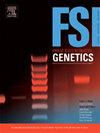利用数字PCR技术提高白腹穿山甲DNA检测灵敏度。
IF 3.1
2区 医学
Q2 GENETICS & HEREDITY
引用次数: 0
摘要
穿山甲被广泛认为是世界上被贩运最多的哺乳动物,由于对穿山甲鳞片、肉和其他衍生物的非法贸易,穿山甲的数量急剧下降。在准确的贸易追踪和成功的刑事起诉方面,一个长期存在的限制是,可用于分析的查获标本质量差,需要开发敏感的检测方法。在这里,我们开发了一种特定的基于mtdna的数字PCR (dPCR)检测方法,用于高度交易的非洲白腹穿山甲(Phataginus tricuspis),并将其应用于广泛的样品类型。通过荧光法和260/230-260/280 nm吸光度比值评估的DNA提取物浓度和质量,由于其固有生物学特性的差异,样品类型之间存在高度异质性。为了最大限度地提高dPCR检测的灵敏度,我们使用了10倍稀释系列,导致适用于任何样品类型的最佳稀释系数为1/1000。由于姐妹种样品(P. tetradactyla)的交叉反应性,我们开发了一种基于阳性分区比例(PPP)的双重策略来定义检测限。这导致Phataginus DNA检测的保守阈值(PPP > 0.00012,约0.16 copies/µL),适用于一般贸易调查,以及P. tricuspis特异性检测的物种特异性阈值(PPP > 0.004,约4.7 copies/µL)。在这些阈值的基础上,我们鉴定分析过的三尖棘虫样品的成功率分别为80-70%。dPCR阴性输出与较低的DNA浓度和偏离理想吸光度比范围的低质量样品显著相关,因此我们建议在dPCR检测之前评估DNA质量指标,以确保最佳的资源分配。目标DNA的水平在不同的样品类型中是可变的。DNA浓度与购买力平价之间的正相关关系表明,在(i)直肠拭子样本(总体上是评估的最佳质量样本)和(ii)骨骼和鳞片样本(可用于贸易场景的主要材料)中,宿主特异性DNA水平很高。据我们所知,我们提出了针对穿山甲开发的第一个dPCR检测方法,从而增加了可用于遏制其非法贸易的法医工具包。尽管我们的预防性dPCR阈值估计,我们建议未来的研究使用可用的样品类型和稀释系列测试重新评估检测限,而在不久的将来,所有物种的多路分析似乎是可以实现的。本文章由计算机程序翻译,如有差异,请以英文原文为准。
Improving DNA detection sensitivity for the white-bellied pangolin (Phataginus tricuspis) via digital PCR
Pangolins are widely regarded as the world’s most trafficked mammals, with their populations plummeting due to intense poaching to supplement the illegal trade in their scales, meat, and other derivatives. A persistent limitation in accurate trade tracing and successful criminal prosecution is the poor quality of seized specimens available for analysis, requiring the development of sensitive detection methodologies. Here, we developed a specific mtDNA-based digital PCR (dPCR) assay for the highly trafficked African white-bellied pangolin (Phataginus tricuspis) and applied it to a wide range of sample types. DNA extract concentration and quality, as assessed via fluorometry and 260/230–260/280 nm absorbance ratios, were highly heterogeneous among sample types due to differences in their inherent biological characteristics. To maximise the sensitivity of the dPCR assay, we used a ten-fold dilution series, resulting in an optimal dilution factor of 1/1000 applicable to any sample type. Due to cross-reactivity in the sister-species samples (P. tetradactyla), we developed a two-fold strategy to define assay detection limits based on the proportion of positive partitions (PPP). This resulted in a conservative threshold (PPP > 0.00012, approximately 0.16 copies/µL) for Phataginus DNA detection, appropriate for general trade investigations, and a species-specific threshold (PPP > 0.004, approximately 4.7 copies/µL) for the specific detection of P. tricuspis. Our success rate in identifying analysed P. tricuspis samples based on these thresholds was 80–70%, respectively. Negative dPCR outputs were significantly associated with lower DNA concentrations and poor-quality samples deviating from ideal absorbance ratio ranges, hence we recommend assessment of DNA quality indicators prior to dPCR testing to ensure optimal resource allocation. Levels of target DNA were variable among sample types. The positive correlation between DNA concentration and PPP indicated high levels of host-specific DNA in (i) rectal swabs, which were overall the best quality sample assessed, and (ii) bone and scale samples, which are the main materials available for trade scenarios. We present, to our knowledge, the first dPCR assay developed for pangolins, thus adding to the forensic toolkit available to curb their illegal trade. Despite our precautionary dPCR threshold estimation, we recommend that future studies reevaluate detection limits using available sample types and dilution series testing, while in the near future a multiplexing assay for all species seems reachable.
求助全文
通过发布文献求助,成功后即可免费获取论文全文。
去求助
来源期刊
CiteScore
7.50
自引率
32.30%
发文量
132
审稿时长
11.3 weeks
期刊介绍:
Forensic Science International: Genetics is the premier journal in the field of Forensic Genetics. This branch of Forensic Science can be defined as the application of genetics to human and non-human material (in the sense of a science with the purpose of studying inherited characteristics for the analysis of inter- and intra-specific variations in populations) for the resolution of legal conflicts.
The scope of the journal includes:
Forensic applications of human polymorphism.
Testing of paternity and other family relationships, immigration cases, typing of biological stains and tissues from criminal casework, identification of human remains by DNA testing methodologies.
Description of human polymorphisms of forensic interest, with special interest in DNA polymorphisms.
Autosomal DNA polymorphisms, mini- and microsatellites (or short tandem repeats, STRs), single nucleotide polymorphisms (SNPs), X and Y chromosome polymorphisms, mtDNA polymorphisms, and any other type of DNA variation with potential forensic applications.
Non-human DNA polymorphisms for crime scene investigation.
Population genetics of human polymorphisms of forensic interest.
Population data, especially from DNA polymorphisms of interest for the solution of forensic problems.
DNA typing methodologies and strategies.
Biostatistical methods in forensic genetics.
Evaluation of DNA evidence in forensic problems (such as paternity or immigration cases, criminal casework, identification), classical and new statistical approaches.
Standards in forensic genetics.
Recommendations of regulatory bodies concerning methods, markers, interpretation or strategies or proposals for procedural or technical standards.
Quality control.
Quality control and quality assurance strategies, proficiency testing for DNA typing methodologies.
Criminal DNA databases.
Technical, legal and statistical issues.
General ethical and legal issues related to forensic genetics.

 求助内容:
求助内容: 应助结果提醒方式:
应助结果提醒方式:


